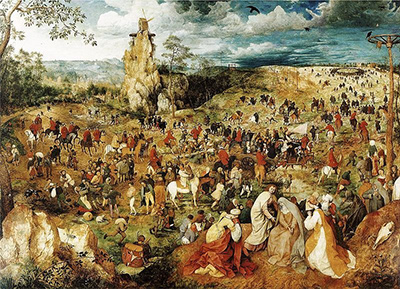Pieter Bruegel was a renaissance painter who produced one of his most famous works, The Procession to Calvary in 1564
Bruegel used oils to create naturalistic paintings that were produced on large canvas'.
The Procession to Calvary is a much beloved painting that depicts Christ, who is seen carrying the Holy Cross amid a picturesque and vast landscape.
This iconic work of art now resides in Vienna at the Kunsthistorisches Museum.
Although there is not much known about the history behind the painting; it is believed that the infamous art collector, Niclaes Jonghelinck, may have commissioned the painting.
He was also known to have collected sixteen pieces of work by the artist.
This is by far one of Bruegel's most traditional paintings.
Art critics have suggested that this may be due to the religious nature of the painting, in that he may have wanted to portray the solemn scene in a respectful manner.
What is most significant about the painting and the technique that Bruegel used, is that although Christ is at the centre of the image, he is actually portrayed as being insignificant, as the many people who make up the crowds, dominate the painting.
This was a well known artistic device at the time, and was used in other paintings including the Conversation of Paul and the Preaching of John the Baptist.
The Procession to Calvary conveys the collapse of Jesus, due to the heavy burden of carrying the Cross.
There are so many intricate images to focus on in this painting. One such detail is that of a small crowd who have gathered to observe the mourning of John the Evangelist and the Virgin Mary.
This is only one of several groups in the painting, which is also reminiscent of works by the painter, Jan van Eyck.




